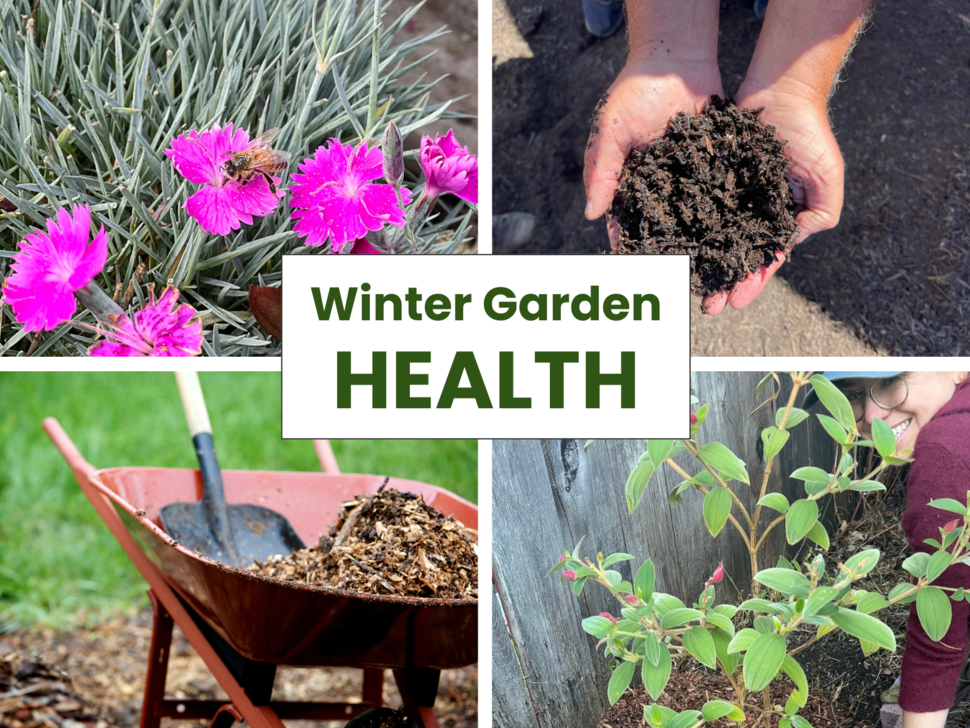Preparing Your East Bay Garden For Winter

Cool Season Care for Soil & Beneficial Insects
As winter approaches in the East Bay, it’s the perfect opportunity to nurture the ecology of your soil and support beneficial insects that play a vital role in your garden. Whether your outdoor spaces are edible or ornamental or both, you can create a thriving environment for both plants and pollinators.
1. Clean Up with Care
While it’s important to remove dead or diseased plant material from your garden beds, do so with a gentle touch. Rather than cutting, raking, and tossing every single thing into your green bin, leave some strategically placed areas of leaves, twigs, and other plant debris in place as habitat for beneficial insects.
Helpful creatures like ladybugs, lacewings, and certain pollinators seek refuge in decaying plant matter during the colder months. This not only helps them survive but also ensures they’ll be ready to do their jobs when spring arrives. Keep this in mind as you tidy up your outdoor spaces for the cold weather months.
2. Feed Your Soil
Healthy soil is the heart of a your garden's ecosystem. As winter rains approach, enrich your soil with organic matter such as high quality compost, worm castings, or aged manure. This creates a vibrant soil community by providing essential nutrients and boosting microbial activity underground. Healthy soil encourages a diverse population of beneficial organisms such as earthworms, which aerate the soil and help with nutrient cycling.
You can also plant cover crops, such as clover, peas, or vetch that help fix nitrogen in the soil and prevent erosion during winter. Once spring arrives, simply cut, smother, or gently turn these low-growing plants into the ground where they will decompose and nourish the soil.
3. Mulch for Moisture and Habitat
Adding a protective layer of mulch to your planting areas is an essential way to maintain ground moisture while supporting beneficial insects and soil health. Organic mulches like wood chips, and shredded leaves help suppress weeds and provide habitat for soil-dwelling creatures.
As these materials break down, they release nutrients back into the soil and help create favorable soil structure. Plus, mulch helps regulate soil temperature in all seasons, protecting the delicate microorganisms that thrive just below the surface.
Pro Tip: When mulching your trees, shrubs, and perennials, avoid mounding the material all the way up to the center of the plants. Instead, place your mulch in a large donut shape around the main trunk or stem and leave a few inches of space. This "donut hole" aeration zone helps prevent diseases while still allowing the mulch layer to protect the soil above the plant's root zone.
4. Create a Pollinator Haven
Winter is a good time to consider how you can support beneficial insects and pollinators in your garden all year long. You may see them out looking for forage on warm winter days or sunning themselves on the leaves of your plants.
As much as possible with your garden's aesthetics, try to leave some plant stems and perennial seed heads standing, as they provide food for birds plus shelter for insects. You can also add insect "hotels" made from bamboo, straw, or hollow stems to give beneficial insects a cozy place to hibernate and reproduce. This will encourage a natural cycle of pest control activity in your garden when spring arrives.
5. Water Wisely
While winter is often wet, it’s important to observe how water interacts with your soil especially following rain. Is there excessive puddling or surface runoff? Does the ground soak up the water slowly or quickly? Remember that standing water can lead to compacted or water-logged garden areas, which are detrimental to beneficial organisms as well as many plants.
If there is no rain for extended periods, check soil moisture in your planting areas and irrigate accordingly. Monitor your plants throughout the cold season since their moisture needs are very different than in the warm season. Water wisely to protect your soil’s structure and your garden's health.
6. Manage Pests with Natural Solutions
Cold weather slows down many pest problems but some destructive bugs might show up in your garden, especially during periods of unseasonably warm temperatures. You can manage them without resorting to harmful chemicals. Instead, use organic pest control methods, such as neem oil or insecticidal soap, that are significantly less harmful to pollinators. A healthy ecosystem thrives on balance, and by protecting those beneficial critters, you’ll create a natural defense system against pests.
7. Think Ahead to Spring
As you prepare your garden for winter, think ahead to your goals for spring. Now is the ideal time to plan for new planting areas, or expand edible garden beds, or add more pollinator plants including California Natives, blooming ornamentals, and flowering edible plants such as fruit trees. These will enrich your garden’s biodiversity and support beneficial insects throughout your neighborhood.
In Closing
Preparing your East Bay garden for winter is not just about protecting your plants. It’s about nurturing the intricate web of life that exists within the soil and among the creatures that call your garden home. By focusing on soil ecology and supporting beneficial insects, you can create a thriving garden environment that flourishes in spring.
At Evergreen Nursery our friendly staff is always here to help with any questions or advice you might need along the way. Happy gardening!



